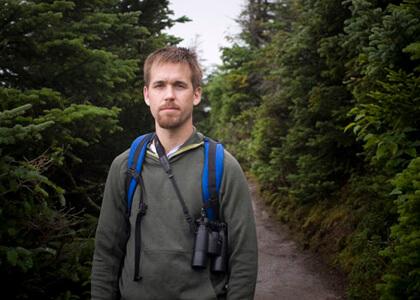In the course of a single year, the temperate hardwood forests of New Hampshire’s White Mountains and foothills transition from a quiet, leafless winter corn maze of grey bark and deep snow to a bud-breaking spring mud-scape rich with spring ephemerals. As the season progresses, a multi-story network of niche patches develops and bustles with the energy of songbirds finding mates, building nests, foraging, and rearing young. As summer becomes fall, the transition back to winter’s relative slow takes hold.
Annual chronological dynamics create an often overlapping succession of seasonal niches for the organisms found therein. The low growing deciduous shrub hobblebush (Viburnum alnifolium) is the focus of one such overlap. At Hubbard Brook Experimental Forest in Grafton County, New Hampshire, the shrub is utilized by moose (Alces alces), a large mammalian herbivore, as winter browse (food) and as nesting substrate for some understory nesting birds including Black-throated Blue Warbler (Setophaga caerulescens). The large, heart shaped leaves of hobblebush are among those first to leaf out in spring capitalizing on greater light transmission through the canopy and providing early cover to spring migrants. Some people recognize hobblebush by the big, unprotected, “praying hands” buds that make this early leaf-out possible. These buds are also what make the plant so appealing to a moose during a nutrient-poor New England winter. Building on the existing understanding of these three species one can imagine the effects of a single lone moose in winter, pruning terminal buds and interrupting apical dominance and somewhat like a bonsai artist, changing the architecture of the understory.
My research questions are as follows: 1) Through the act of browsing, do moose affect the morphology of hobblebush and how? and 2) Do these moose-induced changes have an effect on nest-site selection in Black-throated Blue Warbler?
To answer these questions, I utilized field data gathered by myself and other field technicians over the course of three summers at Hubbard Brook on the distribution of understory shrub/sapling species, the distribution of moose browse and scat, the morphology of individual hobblebush plants, and the collective architecture of a hobblebush patch. These “patches” were established as pairs, and each pair was selected within a single Black-throated Blue Warbler territory. Each pair consisted of a “nest patch” and a randomly selected “non-nest” patch within 30 meters of the nest and meeting a minimum plant density threshold.
Although preliminary, our results suggest that a moose browsed hobblebush will have more branches than an un-browsed plant of the same height. Perhaps more interestingly, it appears that moose forage strategy concentrates this effect in patches. In our comparison of paired hobblebush patches, it appears that patches containing nests are more representative of the aforementioned moose affected condition than non-nest patches and have greater incidence of moose browse.
Moose returned from extirpation to New Hampshire within the last 35 years. Although Black-throated Blue Warbler was successful in the absence of moose, an interaction such as I hope to describe may explain the selective pressures leading to its success. It is my hope that this research will help further our understanding of terrestrial, multi-trophic species interactions in the northern hardwood forests and the web of connections that comprise this particular ecosystem as we know it now.
